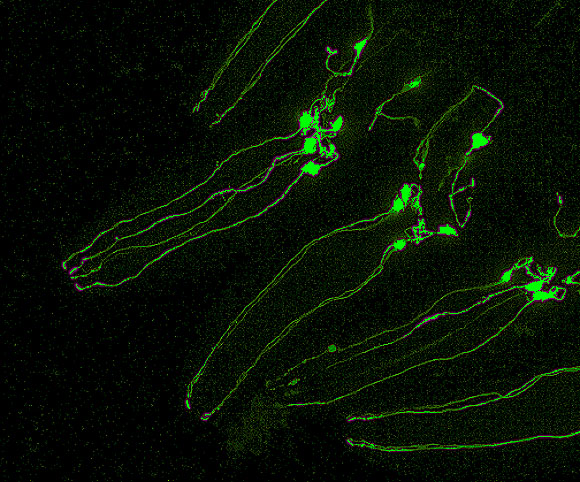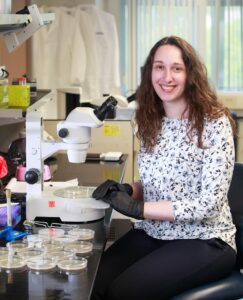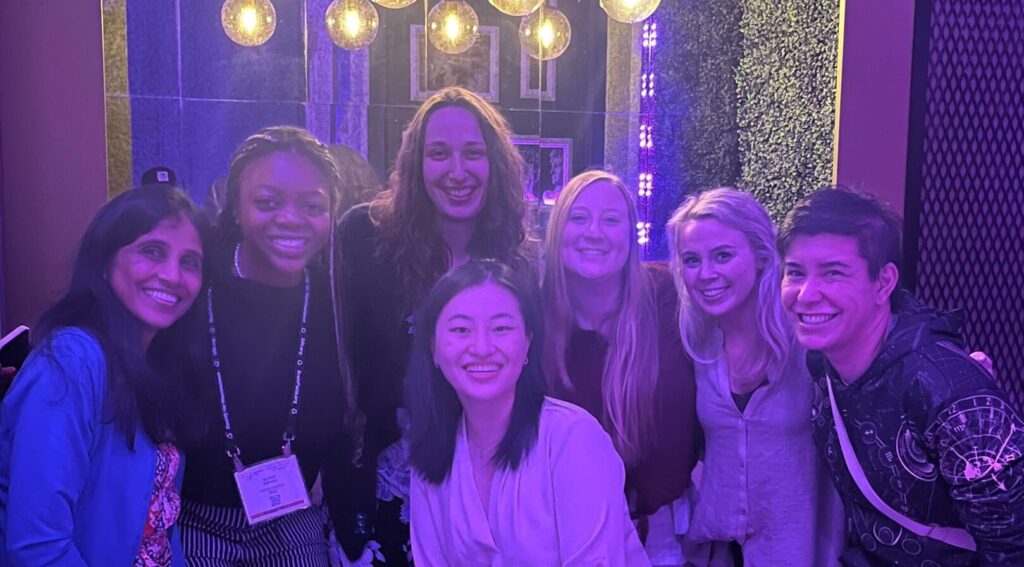Research Overview

 Our lab studies aging and neurodegenerative disorders, with the aim of better understanding disease mechanisms and discovering novel therapies. We use the nematode worm, C. elegans, and a combination of RNA-seq, metabolomics, imaging, and high-throughput genetic and drug screening approaches.
Our lab studies aging and neurodegenerative disorders, with the aim of better understanding disease mechanisms and discovering novel therapies. We use the nematode worm, C. elegans, and a combination of RNA-seq, metabolomics, imaging, and high-throughput genetic and drug screening approaches.
Specific projects in the lab include:
- Generating new animal models of ‘gut-to-brain’ α-synuclein prion-like transmission in Parkinson’s disease
- Understanding synergistic toxicities of α-synuclein and tau in Parkinson’s and Alzheimer’s diseases
- Investigating the role of the gut microbiome in Parkinson’s disease and healthy aging
- Developing new methods for the study of protein aggregation in neurodegenerative diseases using the worm
At right, dopaminergic neurons fluoresce green in the
heads of multiple C. elegans worms.
RESEARCH PUBLICATIONS
- Chen M, Vincent J, Ezeanii A, Wakade S, Yerigenahally S, Mor DE*. Heparan sulfate proteoglycans mediate prion-like α-synuclein toxicity in Parkinson’s in vivo models, Life Sci Alliance 2022; 5(11):e202201366. (*corresponding author)
- McIntyre LM*, Huertas F, Morse AM, Kaletsky R, Murphy CT, Kalia V, Miller GW, Moskalenko O, Conesa A*, Mor DE*. GAIT-GM integrative cross-omics analyses reveal cholinergic defects in a C. elegans model of Parkinson’s disease, Sci Rep 2022; 12(1):3268. (*co-corresponding authors)
- Sohrabi S, Mor DE, Kaletsky R, Keyes W, Murphy CT. High-throughput behavioral screen in C. elegans reveals Parkinson’s disease drug candidates, Commun Biol 2021; 4(1):203.
- Mor DE, Sohrabi S, Kaletsky R, Keyes W, Tartici A, Kalia V, Miller G, Murphy CT. Metformin rescues Parkinson’s disease phenotypes caused by hyperactive mitochondria, Proc Natl Acad Sci U S A 2020; 117(42):26438-26447.
- Mor DE, Murphy CT. Mitochondrial hyperactivity as a potential therapeutic target in Parkinson’s disease, Transl Med Aging 2020; 4:117-120.
- Mor DE, Daniels MJ, Ischiropoulos H. The usual suspects, dopamine and alpha-synuclein, conspire to cause neurodegeneration. Mov Disord 2019; 34(2):167-179.
- Yao V,* Kaletsky R,* Keyes W,# Mor DE,# Wong AK, Sohrabi S, Murphy CT, Troyanskaya OG. An integrative tissue network approach to identify and test human disease genes. Nat Biotechnol 2018; 36:1091-99. (*#equal contribution)
- Mor DE, Ischiropoulos H. The convergence of dopamine and α-synuclein: Implications for Parkinson’s disease. J Exp Neurosci 2018; 12:1179069518761360.
- Mor DE, Tsika E, Mazzulli JR, Gould NS, Kim H, Daniels MJ, Doshi S, Gupta P, Grossman JL, Tan VX, Kalb RG, Caldwell KA, Caldwell GA, Wolfe JH, Ischiropoulos H. Dopamine induces soluble α-synuclein oligomers and nigrostriatal degeneration. Nat Neurosci 2017; 20(11):1560-68.
Featured in Nat Neurosci 2017; 20(11):1514-15
Featured in Mov Disord 2018; 33(2):249. - Mor DE,* Ugras SE,* Daniels MJ,* Ischiropoulos H. Dynamic structural flexibility of α-synuclein. Neurobiol Dis 2016; 88:66-74. (*equal contribution)
- Gould N, Mor DE, Lightfoot R, Malkus K, Giasson B, Ischiropoulos H. Evidence of native α-synuclein conformers in the human brain. J Biol Chem 2014; 289(11):7929-34.
- Hartman NW, Carpentino JE, Lamonica K, Mor DE, Naegele JR, Grabel L. CXCL12-mediated guidance of migrating embryonic stem cell-derived neural progenitors transplanted into the hippocampus. PLoS One 2010; 5(12):e15856.
Danielle Mor, PhD

 Dr. Mor is highly passionate about research and teaching in the fields of neurodegenerative disease and aging. Diseases such as Alzheimer’s and Parkinson’s are rapidly growing in prevalence. The urgency of this public health concern and the fascinating mechanisms underlying these disorders – including the important role of the gut microbiome – have compelled Dr. Mor to devote her career to pursuing these areas of research.
Dr. Mor is highly passionate about research and teaching in the fields of neurodegenerative disease and aging. Diseases such as Alzheimer’s and Parkinson’s are rapidly growing in prevalence. The urgency of this public health concern and the fascinating mechanisms underlying these disorders – including the important role of the gut microbiome – have compelled Dr. Mor to devote her career to pursuing these areas of research.
Trained at the University of Pennsylvania for her PhD in Neuroscience, and at Princeton University for her postdoc, Dr. Mor is now the head of her own research group in the Department of Neuroscience & Regenerative Medicine at the Medical College of Georgia at Augusta University, located in Augusta GA.
When she is not in the lab excitedly looking at worms, Dr. Mor can be found taking walks in nature, watching baking shows, and spending time with her friends and family.
Our Team


From left to right: Shobha Yerigenahally, Alexis Ezeanii, Danielle Mor, Merry Chen, Nicole Johnson, Julie Vincent, Kieran Szelong
Our Funding Sources

Department of Defense Early Investigator Research Award
Medical College of Georgia at Augusta University Start-Up Fund